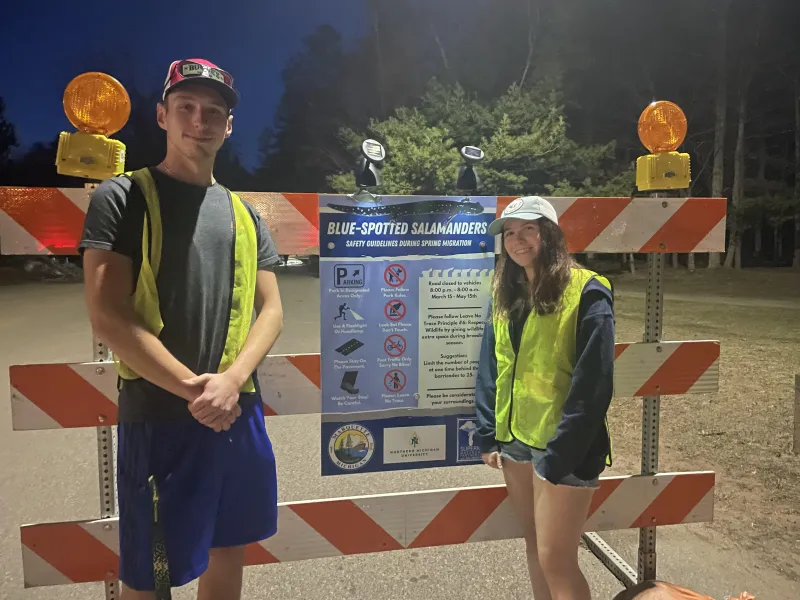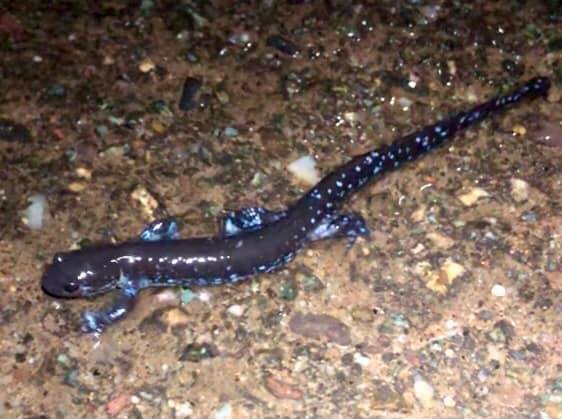When the spring thaw begins at Marquette's Presque Isle Park and there are a couple of rainy nights with temperatures in the 30s and 40s, blue-spotted salamanders suddenly emerge from their underground winter burrows. They migrate across remaining snow and the park's road to lay their eggs in a wetlands area behind the Moosewood Nature Center, then return to the other side. An NMU alumnus who saw too many squished to death by vehicle traffic convinced the city to close the park road in the evenings while they are moving. Now, more than 40 NMU students are trained for duty in salamander conservation, data collection and public education efforts associated with the migration.
“Marquette really loves its salamanders and wants to see them thrive,” said Anna Hill, a Freshman Fellow and biology major with a concentration in ecology from Port Sanilac, Mich. “It's amazing how residents have fallen in love with something that's only out and viewable for about two weeks and want to ask all sorts of questions. Adorable kids come up to me, sharing what they've learned about the animals or telling salamander jokes. I guess you could say we're tackling the conservation aspect ahead of time.”
“There has been an astronomical number of people showing up at the park already compared with last year, and we're not even at the peak of the run yet,” said Luke Childs, a senior fisheries and wildlife management major from Lapeer, Mich. “I'm leading the Salamander Stewards team, which patrols the road to ensure that salamanders aren't being harmed, picked up, or otherwise disrupted on their journey. The team also educates community members on what's happening, why, and characteristics of the animals. It's great to have community interest and involvement, provided it's in a way that allows for a safe migration.”
Hill is leading Team Sallie, which is focused on collecting data that is scientifically sound in order to augment and validate the observations of participants in the department's Citizen Science program. She trained students to record the number of salamanders they see, the timing of their movements, whether they're traversing through remaining snow—there is barely any left after the recent warmup—general weather conditions, and species identifications.
“There are actually two types of salamanders at Presque Isle,” Hill said. “The blue-spotted male and female salamanders are typically smaller and have darker bodies with brighter spots that are more distinguishable. Then there's a unisexual female hybrid variant. They're usually bigger and their spots are muddled together and less bright, with some gray in them. But you can't really tell the difference without genetic testing. There's been a lot of literature on the genetics of these salamanders, but not on their migration or ecology.”
Hill is in Northern's Freshman Fellowship program, which allows academically talented students to earn money as an assistant to a faculty member in a research project. Hill expressed thanks to the program's team for pairing her with Jill Leonard, head of the Biology Department.
“It's nice to have a direct way to communicate with someone who has such a large knowledge base,” Hill said of Leonard. “It may not be a traditional Freshman Fellowship to be out in the field from 9 p.m. to 1 a.m. like this. It's tiring, but very rewarding. When I first started this project, I put in 25 hours of work toward animals I hadn't even seen yet. But now they're moving full force with the migration and it's so rewarding. Being able to do something like this my first year at Northern is transformative."
In addition to serving as a steward, Childs has also engaged in research. One future project involves studying the eggs and their life cycle for hatching, as well as when the freshly hatched salamanders cross the road to join the adults. He said the overall experience related to this conservation effort is good preparation for his future career goal of becoming a fish and game officer with the DNR.
“I really enjoy being up here in Marquette, and I'm grateful to the faculty and staff at NMU for giving me the opportunity to work on this project,” he said. “Conserving wildlife is a passionate goal of mine and I'm helping with that so future generations will have these salamanders around to experience. It's awesome to see how much it lights up little kids' faces when they see their first salamander up close.”
The conservation effort is a collaboration involving NMU's Biology Department, the Superior Watershed Partnership and City of Marquette.


